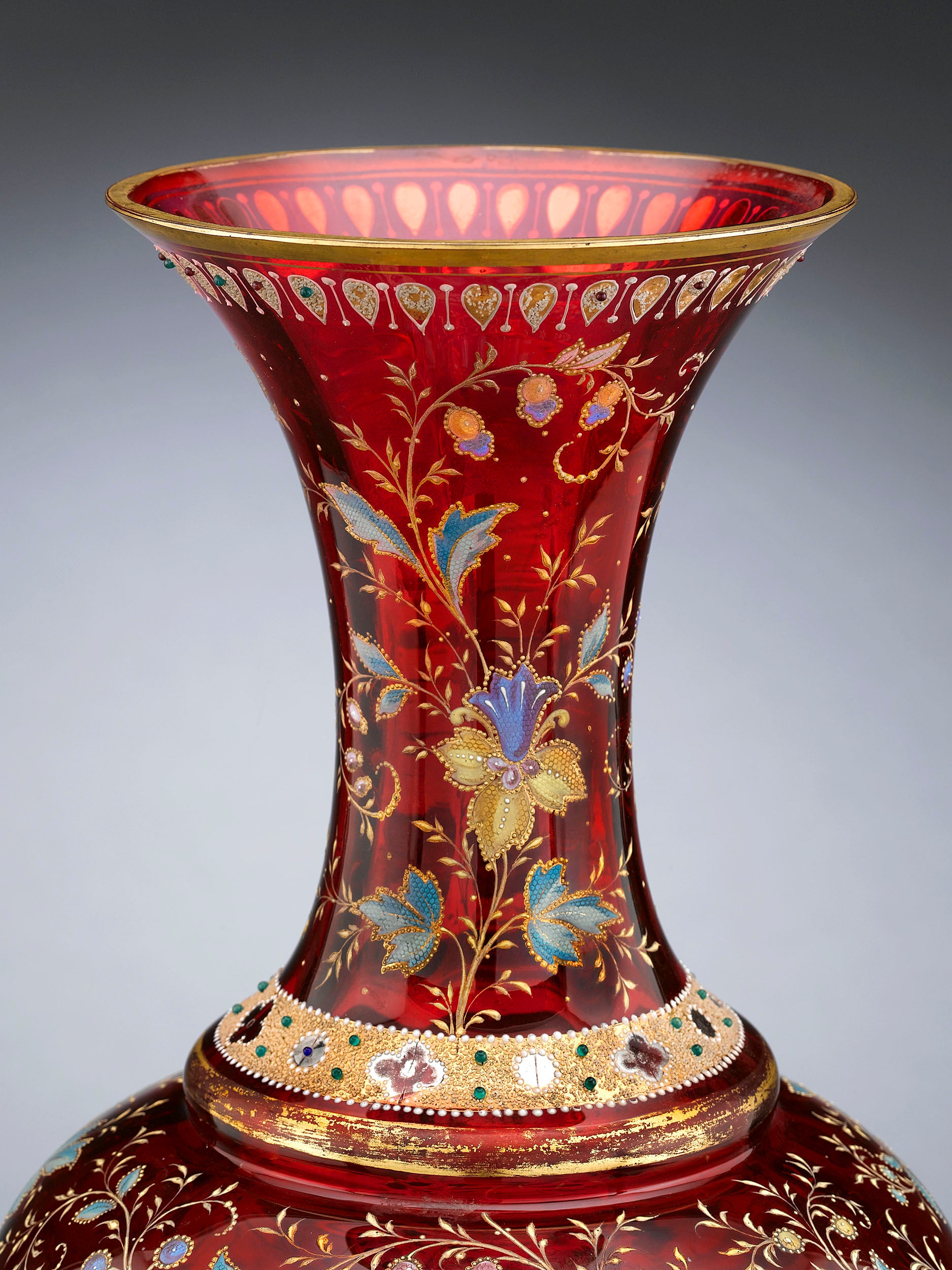Colored glass remains one of the most fascinating mediums in the decorative arts. It's a craft that's existed for centuries, from Ancient Egypt to modern time, with maker-giants such as Tiffany Studios, Moser, and Gallé. But no matter the era, colored glass art has consistently been one of the foremost decorative techniques throughout history. If you want to learn more about the different types of antique glass, you have come to the right place. Read more to learn about the techniques, craft, and history of colored glass and vintage glassware.
The Medium
The medium of colored glass has been applied to numerous types of objects throughout history. From adorning and essentially completing, Gothic-style cathedrals in Western Europe to topping glass lamps, colored glass is an indispensable art form. Artisans even used this vintage glass-making technique to create stunning vintage glassware, vase pieces, and other crystal wear.
Basic Technique of Making Colorful Glass
Essentially, glass is the final product of fusing different types of materials: sand, salt, metallic oxide, and powdered flint.
The ancient technique of colored glass making is remarkably similar to today's modern methods, and laid an essential foundation for future glass innovators to build upon. The basic ingredients for the ancient method of cut glass included: sand (which acted as the main component), soda ash, salt, and white plant (to which little is known). In addition, ancient art glass craftsmen would utilize a copper compound, which was used as a colorant in glass pieces.
Modern techniques of art glass making include many of the same materials, such as sand and soda ash, but include a wider variety of metals to achieve different colors.
Application of Color in Glass
The application and inclusion of color in antique glass often define the desirability, value, and function of the glass object. While ancient cultures, the earliest people who worked with glass, primarily utilized a copper-based substance to achieve glass color, modern methods employ various different metals to give glass objects nuanced, vibrant, and exceptional coloring.
If you examine a stained-glass window design, different areas owe their colors to different metals and elements. At Chartres Cathedral, for example, the north transept rose window is dedicated to the Virgin Mary and Child, depicting the entire narrative depiction through the colorful glass. The blue of the Virgin Mary’s robe is a result of the addition of cobalt oxide and cobalt carbonate into a glass melt. The gold of the Child’s cloak, for example, is a result of the combination of sulfur, carbon, and iron salts into the original glass recipe of sand and soda ash.
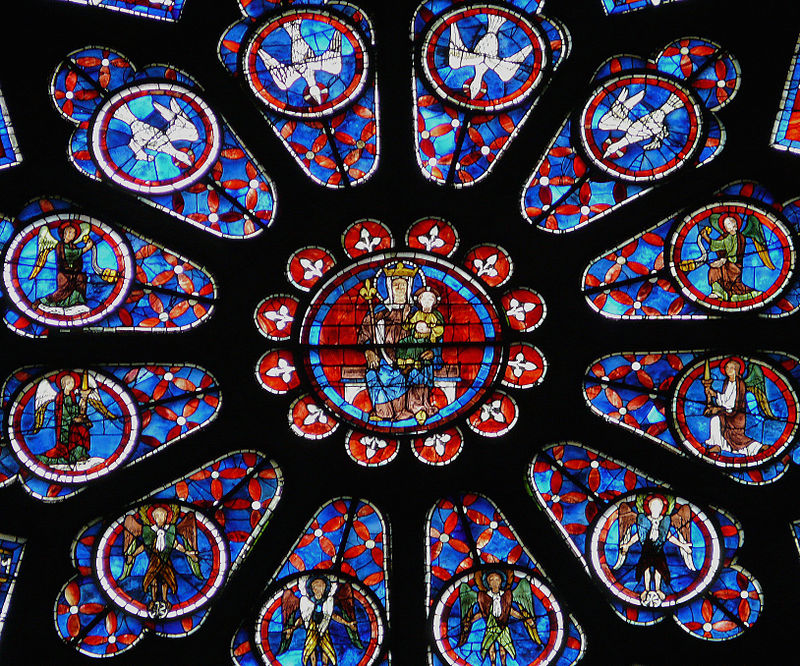
Do these colors in antique glassware and art pieces last? In some cases, certain colors are not as durable against outside agents, such as sun exposure. Some colors, when exposed, would darken while others would lighten or fade. It was found, very early on, that red was the most susceptible and vulnerable to fading. Upon this finding, innovative glassblowers tirelessly worked to produce a red color whose vibrant hue would remain permanent against sun exposure. By adding small amounts of gold to the red glass recipe, glass craftsmen found that the red would remain strong for years against outside agents.
 Red glass perfume bottle by Thomas Mellish
Red glass perfume bottle by Thomas Mellish
What other metals are utilized to achieve different colors in antique colored glass objects? View the list below to learn more:
- Yellow – Lead Compounds
- White – Tin Compounds
- Yellow – Amber - Sulfur
- Violet – Nickel Oxide
- Purple – Manganese Dioxide
- Red – Gold Chloride
- Blue, Green, Red – Copper Compounds
- White – Antimony Oxides
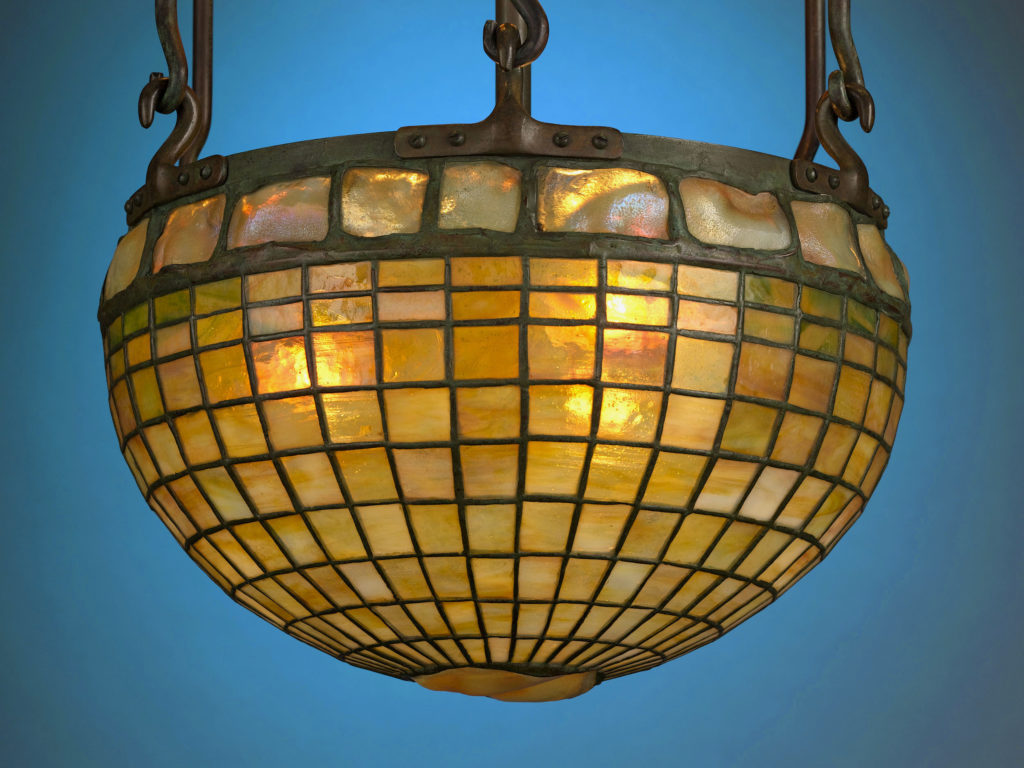 A Geometric-style Tiffany Studios chandelier that exhibits impressive yellow and amber-colored glass
A Geometric-style Tiffany Studios chandelier that exhibits impressive yellow and amber-colored glass
Throughout History
Because the history of glass craft and techniques has long existed and gone through multiple phases, it’s important to touch on each pivotal moment during its development to fully grasp its importance.
Ancient Roots
While little is known about the first attempts at glass making, historical documentation has provided us with numerous references to colored glass craft throughout different cultures. Generally, it is accepted that experimentation in glass-making began nearly 5,000 years ago in Mesopotamia. Phoenician sailors are thought to have landed on a beach and prepared a fire - discovering that the sand beneath the fire melted and hardened into glass. However, it took a long period of time - and countless variations and experimentation - to discover and ultimately perfect the technique of glassmaking. Importantly, during this time, only affluent and royal individuals were permitted to obtain and utilize glass objects.
The Roman Empire

In 300 B.C., a major technological innovation occurred: Syrians invented the blowpipe, and the modern technique and foundation for glass formation was finally laid. The Roman Empire embraced this new technique, and glassmakers and craftsmen now could create glass pieces in a wide variety of shapes and forms. Importantly,t it is in this century that class craftsmen developed formulas to apply and incorporate different colors into glass. Consequently, the process of glassmaking became more widespread and affordable – allowing those outside of the elite and royal social classes access to glass pieces.
During the Roman Empire, glass alabastrons were a popular glass item. Used to hold perfumed oil and medicinal solutions, the widespread use of iridescent alabastrons are a testament to the popularity and use of glass during the Roman Empire.
 An Ancient Roman Glass Alabastron, once used to hold perfumed oils or other medicinal solutions
An Ancient Roman Glass Alabastron, once used to hold perfumed oils or other medicinal solutions
Middle Ages
Fast forward to the Middle Ages, following the collapse of the Roman Empire up until the Renaissance period. During this long era, Venice became the European nucleus for glass making – commanding the market and the techniques. Essentially, Venice maintained an enormous monopoly on glass.
Striving to maintain their control, the Venetian government forced all glassblowers to the nearby island of Murano. Importantly, it is here that glass craftsmen began infusing their glass pieces with vivid, jewel tones such as rich greens, royal blues, and velvety purples. While the glassblowers were legally restricted to Murano, some did manage to escape and spread their newfound coloring techniques throughout Europe.
 An example of Murano glass, a vivid blue chandelier, circa 1880
An example of Murano glass, a vivid blue chandelier, circa 1880
During the 12th century, great cathedrals were built across Western Europe. Enormous in size, craftsmen were tasked with decorating the interiors of the massive structures. The first form of art that they turned to was colored glass. Craftsmen were commissioned to create colossal stained-glass windows, taking advantage of the soaring walls to flood the interior with vibrant light. By now, glass-making techniques that incorporated different colors into glass objects had spread across Europe, and different innovators were adopting the practices.
Today, stained glass windows are synonymous with the Gothic period and are closely tied to the prevalent architecture. Gothic stained-glass windows acted as both narrative outlets and objects of pure beauty; the windows gave both a visual glimpse into essential Biblical tales for a largely illiterate populous and provided an unsurpassed optical experience within the cathedrals.
Renaissance
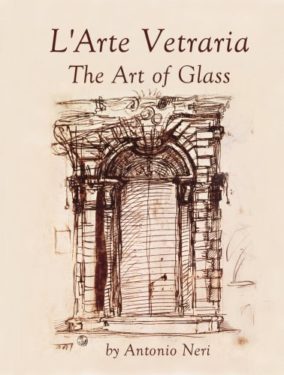
During the Renaissance, a time strongly characterized by a re-birth of humanism, technology, science, and philosophy, a pivotal moment in glassmaking occurred: the publishing of the first textbook on glassblowing, Arte Vetrarie (The Art of Glass). Published in Italy by a Florentine priest named Antonio Neri, this book gained significant recognition as it formally disclosed Venetian glassmaking techniques and revealed various glassmaking methods used to achieve different styles, such as leaded glass and diamond engraving.
Early America
Established in 1607, the Jamestown colony was the first permanent settlement in North America. Approximately 105 colonists departed England, bringing numerous objects to live out their daily lives in the new land. During their initial stay, colonists were still receiving functional and decorative glass wares imported from Europe. However, by the 1880s, there existed more glassmakers unique to America with the invention of the mechanical press. With the invention of this press, two people could easily craft an object of glass. By utilizing the press, one person brought the hot glass from the furnace to the mold, and the second cut off the right amount of glass to enter the patterned mold. Once the mold was squeezed, a decorated piece of glass came out in seconds.
Art Nouveau
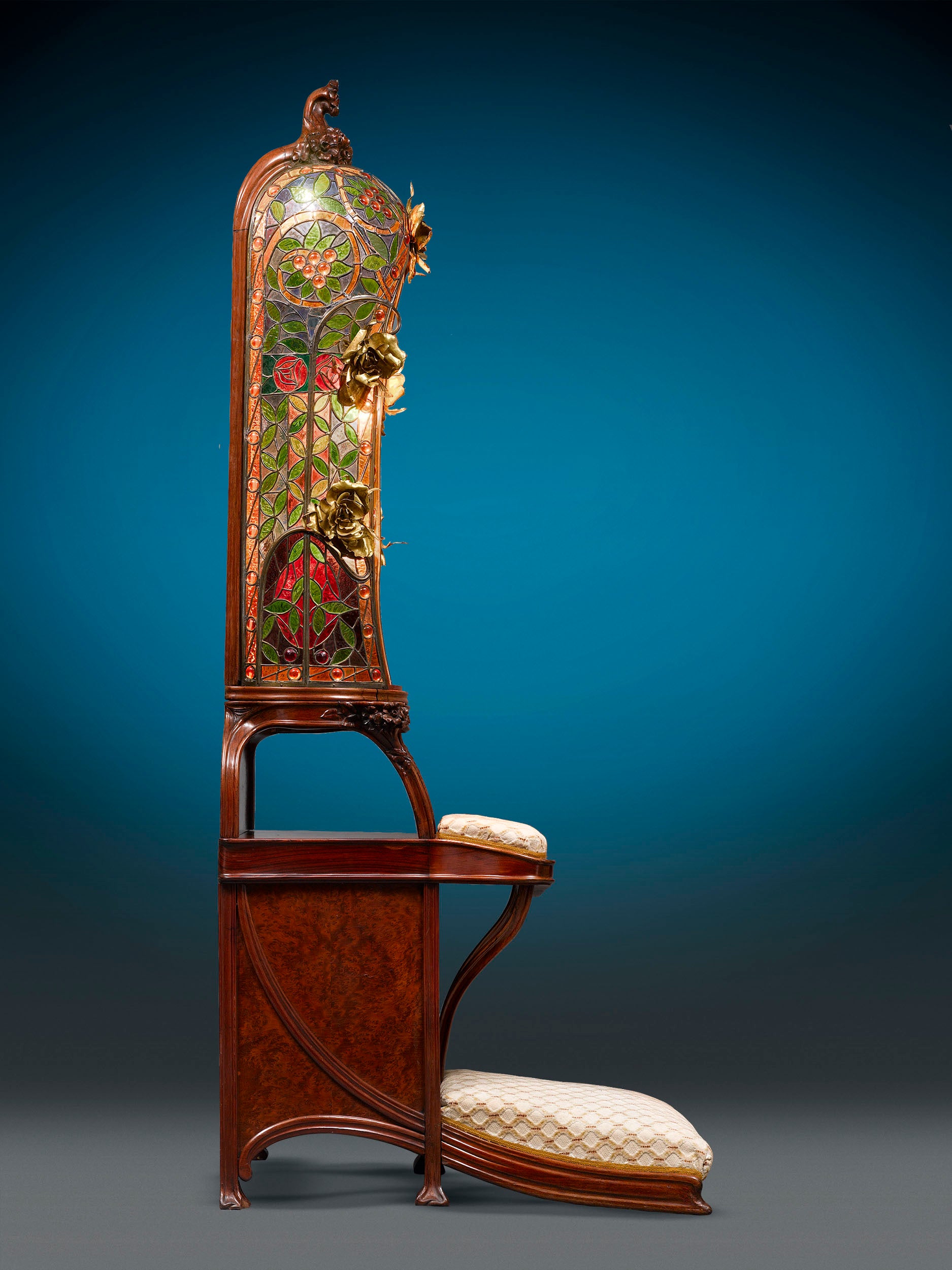
Glass production throughout the 19th century was an enormously inventive time: countless artisans crafted contemporary glass and glassmaker, such as Lalique and Gallé, rose to high fame. The Art Nouveau period is perhaps the most pivotal time for the proliferation of colored glass as an art form. In other words, it was during this period that a marriage between glass production and aesthetic art was formed. Art Nouveau glass is now some of the most stunning art glass pieces you can find in any antique collection.ection.
Glassmakers during the Art Nouveau era welcomed and incorporated the swirling lines, natural motifs, and organic, characteristics of the period, into their elegant glassworks. Often, makers, such as Gallé, would give their glass pieces an intensely foliate look and accentuate the foliate natural with vivid colorings, such as grassy greens and jewel-toned blues and reds.
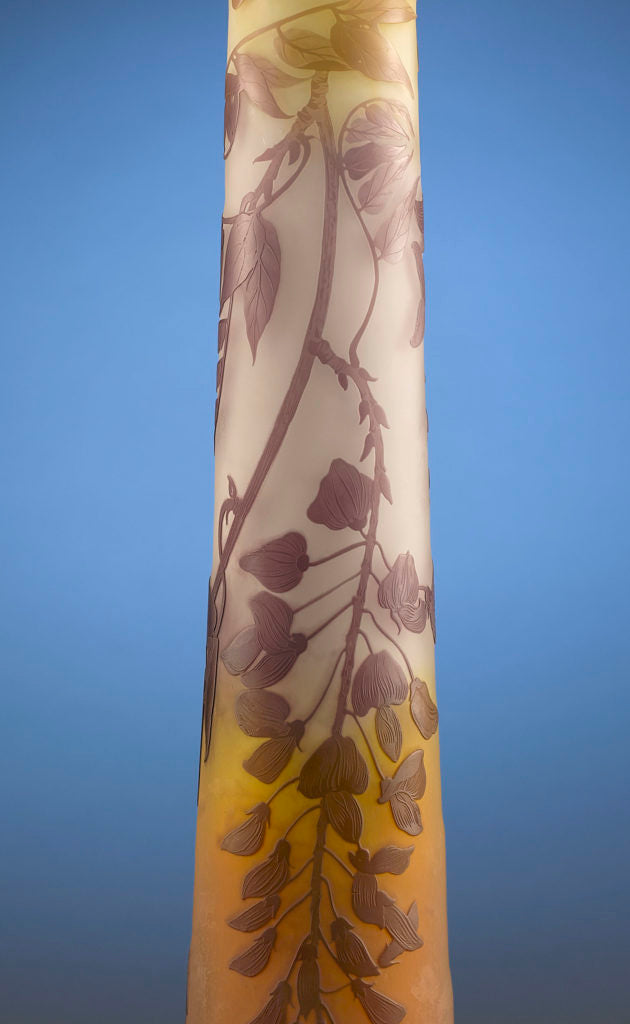 Cameo Glass Vase by Emile Gallé that depicts natural, foliate motifs of the Art Nouveau period
Cameo Glass Vase by Emile Gallé that depicts natural, foliate motifs of the Art Nouveau period
Tiffany Studios crafted an entirely new line of vintage glass to coincide with the popularity of the Art Nouveau movement. Designed as "Favrile," these glass pieces were comprised of strikingly colored iridescent glass. To even further match the foliate nature of Art Nouveau, Tiffany shaped each glass piece into flowers and other foliate shapes.
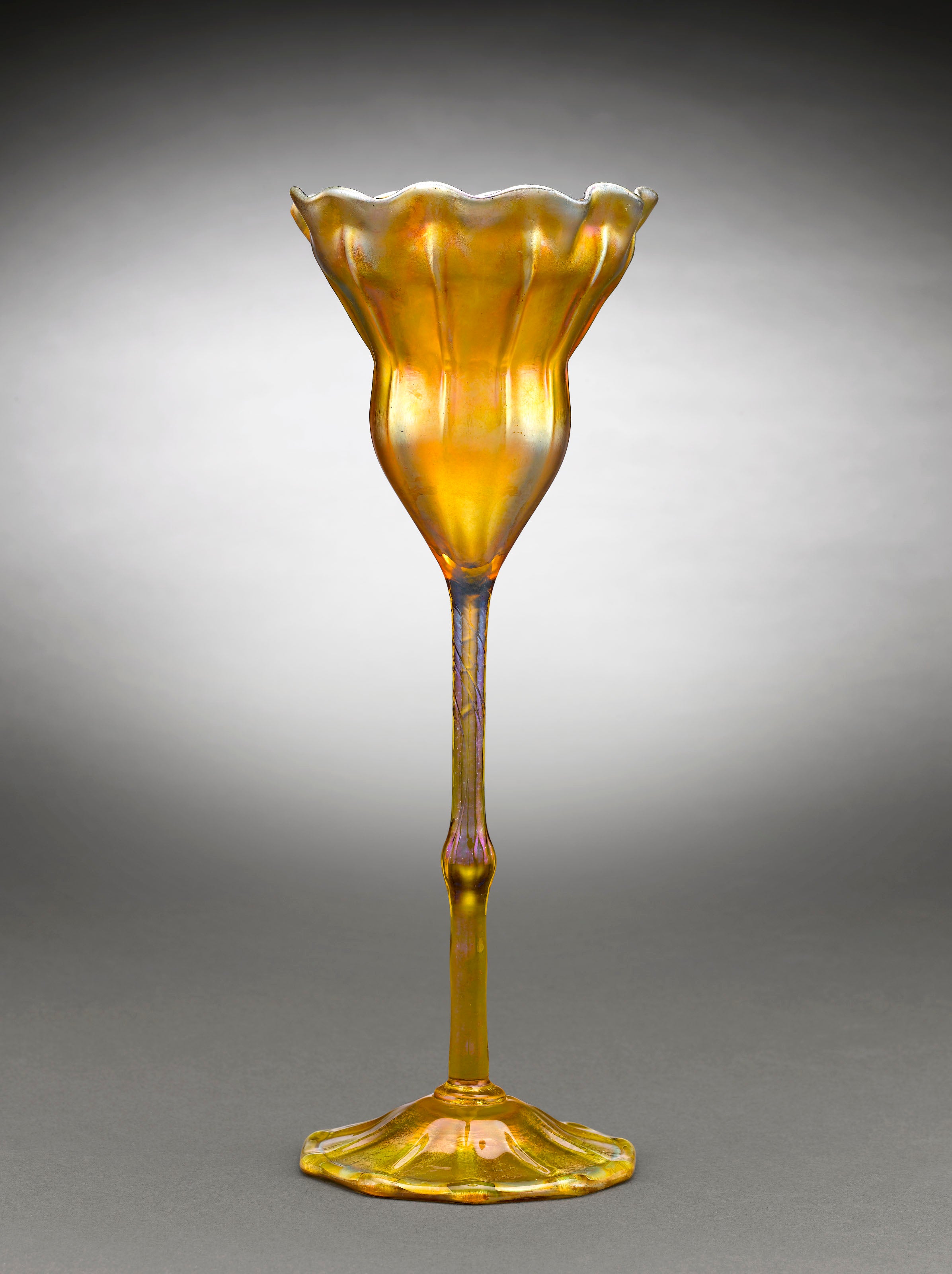 Tiffany Studios crafted a series of crystal glass called Favrile glass, that featured natural forms of strikingly iridescent-colored glass
Tiffany Studios crafted a series of crystal glass called Favrile glass, that featured natural forms of strikingly iridescent-colored glass
Colored Glass Spotlight

Bamboo Windows crafted by Tiffany Studios., circa 1910
By the turn of the 20th century, Tiffany Studios became masters, and specialists, at colored glass creation. Their lamps, chandeliers, and objets d'art fascinating glass connoisseurs and the everyday passerby alike. Their stylized, striking pieces captivated the world. Their stained glass windows, on the other hand, maintained an entirely greater presence all on their own.
This pair of Tiffany Studios stained glass windows exhibits the brilliance and outstanding ability that distinguish the work of Louis Comfort Tiffany from that of all other glassmakers Looking to the prevalent Art Nouveau style, shoots of towering bamboo are depicted in a lush mosaic of deep greens and browns set upon a backdrop of golden yellow glass. These windows must be experienced in person, as they showcase an outstanding visual effect when viewed in transmitted and then reflected light.
 Bamboo Tiffany Windows by Tiffany Studios, detail
Bamboo Tiffany Windows by Tiffany Studios, detail
While most of Tiffany's window commissions were of ecclesiastical subjects, the artist was at his best when designing windows with nature as his inspiration. The Bamboo pattern is among the most admired in his repertoire and is an excellent example of the popular Art Nouveau style of the time.
The windows are displayed and illuminated in custom-built, ebonized cases.
Glass Terms to Know
- Acid Etching – a technique used to decorate the surface of glass objects. The glass object is submerged in hydrofluoric acid and then etched in the desired design. Other techniques can be exposing the piece to the fumes of hydrofluoric acid, giving the piece an all-over matte effect.
- Abrasion – a technique used to decorate the surface of glass objects. The surface of a glass object is grinded down to create a shallow-relief decoration.
- Alabastron - frequently crafted during the Roman Empire, a small glass bottle or flask-shaped object used to hold perfumes and oils
- Ancient Glass – a term frequently applied to all pre-Roman and ancient Roman glass.
If you are looking to add a colored piece of elegant glass that's in pristine condition, shop our one-of-a-kind glass collection at M.S. Rau Antiques. Our selection of colored and molded glass offers a variety of design options to accommodate all collectors. Browse our stunning pieces of molten glass right on our website or in our in-person showroom.
Source:
BBC. The 10 Greatest Stained-Glass Windows in the World. https://www.bbc.com/culture/article/20140630-the-10-best-stained-glass-windows

